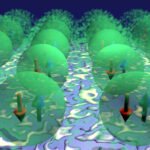Magnonic computing: Faster spin waves could make novel computing systems possible
Researchers at the University of Vienna have made significant progress in the field of magnonics, a burgeoning area focused on utilizing waves in magnetic media to transmit information. In a recent study published in the journal Science Advances, the team revealed a breakthrough method for improving the speed of magnon-based data processing units.
Magnonics exploits spin waves, disturbances in the magnetic order of a material that propagate as waves. These waves, known as spin waves or magnons, can carry information as angular momentum pulses, offering a potential avenue for low-power and energy-efficient data carriers in future computers.
The challenge in magnonics lies in the wavelength of the spin waves, with longer wavelengths leading to slower data processing units. Traditionally, shortening the wavelength required complex hybrid structures or sophisticated equipment. However, the Vienna research group found a simpler alternative: by increasing the intensity of the spin waves, they could be made shorter and faster, a method analogous to changing the color of light by altering its intensity.
This new approach allowed the team to achieve a spin wave wavelength of about 200 nanometers. While simulations suggest even smaller wavelengths could be achieved, the practicality of exciting or measuring such minute scales remains challenging.
The researchers also noted the importance of spin wave amplitudes for future magnetic integrated circuits. The discovered system exhibited a self-locking nonlinear shift, resulting in constant amplitudes of the excited spin waves. This property is vital for integrated circuits as it enables different magnetic elements to work together coherently, a crucial aspect for constructing more intricate systems and, ultimately, realizing the goal of a magnon-based computer.
While a fully functional magnon computer remains an ongoing endeavor, this breakthrough brings researchers significantly closer to achieving this ambitious objective.































